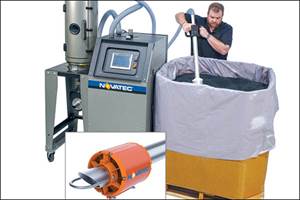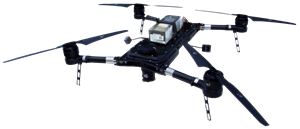Smart Manufacturing Means 'Fix It Before It's Broke'
If you want to get the most out of your plant, you need to concentrate on preventing problems, not fixing them once they've occurred. That's the basic concept of "pre-emptive process control," which is the aim of software and hardware options recently introduced for the Source 1.3 CIM system from Hunkar Laboratories Inc., Cincinnati.
If you want to get the most out of your plant, you need to concentrate on preventing problems, not fixing them once they've occurred. That's the basic concept of "pre-emptive process control," which is the aim of software and hardware options recently introduced for the Source 1.3 CIM system from Hunkar Laboratories Inc., Cincinnati. The new Windows-based software tells you whether any aspect of your process quality is degrading--even before the process drifts far enough to make bad parts. The software then tells you where to focus your maintenance efforts to get things back on track. A new "Smart Beeper" paging system can broadcast the process status and the recommended actions directly to technicians or supervisors.
As explained by company chairman Denes Hunkar, "Profitability comes from eliminating waste in all facets of manufacturing. Current CIM techniques based on monitoring cannot tap this potential because by the time we recognize that waste is happening, it's too late." With the new software, Hunkar says, "The focus is placed on prevention to improve profitability." That is the essence of what he calls Smart Manufacturing.
How capable a machine?
The heart of Hunkar's Smart Manufacturing concept is new software called Maintenance Wizard. It provides continuous and almost instantaneous updates of the "process capability" of a machine. "Capability" means the ability to maintain a process parameter within a narrow deviation band above and below the mean. Maintenance Wizard determines the absolute width of that band for each parameter monitored. Hunkar calls this "current machine capability," or CMC.
To give molders a quick yardstick for evaluating CMC, Maintenance Wizard expresses it in terms of "Class Factors," a nine-level scale in which Class 1 indicates the tightest and Class 9 the loosest degree of control. The Wizard applies a Class Factor to each individual parameter being monitored.
Maintenance Wizard runs continuously, updating the Class Factors for each machine automatically within 3 sec. In the past, calculating Class Factors required some manual work and took about a half hour.
Now, in seconds, the Wizard compares the Class Factor for each parameter to the previous value and actuates an automatic alarm if process control has deteriorated. "Our observation indicates that at this point the manufactured parts are still substantially unaffected," Hunkar says.
He notes that keeping records of the CMC Class Factors that produce good parts on each mold makes possible "smart scheduling." With the CMC data provided by Maintenance Wizard, the Source CIM system can indicate which available machines match the CMC profile required by a given mold. It can post a warning if the user attempts to schedule a machine that is not currently "capable" enough for that mold.
What to fix first?
If the Wizard detects a degradation in process quality, it helps the molder decide what to do about it. One way is through automatic posting of "system notes". A message in plain language identifies the machine, the time, and the parameter that is wandering. These messages will not go away until they are acknowledged. The diagnostic messages and process data (for the three parameters that most urgently need improvement) can be automatically sent via Smart Beeper to pagers worn by personnel throughout the plant.
Maintenance Wizard also helps prioritize action to reverse process degradation through real-time Pareto charts, as in Fig. 3. Lengths of the bars show the number of excursions beyond upper and lower control limits. The bars are colored red, yellow, and green. Red bars are not necessarily the longest, but are those most urgently needing maintenance action. Color coding is based on a new financial calculation of cost-effectiveness--i.e., the importance to product quality of fixing this parameter balanced against how much time it will take to fix it. Not all process excursions justify immediate attention, Hunkar explains. "Maintenance work should be done first where the financial payback is highest. The computer sets the priority, not the maintenance guy."
The same color coding is used in the diagnostic report. The machine icons are color coded green (OK), yellow (occasional problems), red (severe problems), and gray (no data).
Sift good data from noise
Hunkar says another important new feature of Maintenance Wizard is that it "cleans up" the "dirty data" that monitoring systems typically collect from a molding process. "Dirty data includes spikes, noise, dropouts, and the occasional effect of manual adjustments that follow no rule or logic," Hunkar says. Until now, he adds, monitoring systems analyzed the health of a process based on the maximum and minimum deviation from the mean, regardless of the extent to which those values were influenced by process "noise." Hunkar says Maintenance Wizard uses proprietary methods to screen out the noise, without distorting or smoothing the data, in order to determine which data are truly significant.
He cites the example of a process that would be running well except for excessive mold-open time. The root of the problem might be the operator's behavior or possibly a sticking core or ejector. However, longer hold-up time in the barrel would produce a hotter, less viscous, and less dense melt. That could show up as shorter injection time and shorter injection stroke, and perhaps ultimately as short shots. The Wizard embodies an "expert system" that would not downgrade the CMC for injection time and stroke, but would flag mold-open time as the culprit demanding attention.
What it costs
Maintenance Wizard software costs about $3000. The Smart Beeper is a Motorola system based on a transmitter within the plant. It avoids the 10-30 min delays that can occur with satellite-based paging systems. The transmitter costs about $1500 and each pager about $250.
Related Content
New Technology Enables ‘Smart Drying’ Based on Resin Moisture
The ‘DryerGenie’ marries drying technology and input moisture measurement with a goal to putting an end to drying based on time.
Read More50 Years of Headlines … Almost
I was lucky to get an early look at many of the past half-century’s exciting developments in plastics. Here’s a selection.
Read MoreDrones and Injection Molding Ready for Takeoff
Drones and unmanned aerial vehicles (UAV) are approaching an inflection point where their production volumes — and functionality — will increasingly point to injection molding.
Read MoreAutomation in Thermoforming on the Rise
Equipment suppliers’ latest innovations exemplify this trend driven by factors such as labor shortages, higher-speed thermoformers and tighter quality control.
Read MoreRead Next
For PLASTICS' CEO Seaholm, NPE to Shine Light on Sustainability Successes
With advocacy, communication and sustainability as three main pillars, Seaholm leads a trade association to NPE that ‘is more active today than we have ever been.’
Read MoreLead the Conversation, Change the Conversation
Coverage of single-use plastics can be both misleading and demoralizing. Here are 10 tips for changing the perception of the plastics industry at your company and in your community.
Read MoreRecycling Partners Collaborate to Eliminate Production Scrap Waste at NPE2024
A collaboration between show organizer PLASTICS, recycler CPR and size reduction experts WEIMA and Conair will seek to recover and recycle 100% of the parts produced at the show.
Read More


















 (2).jpg;maxWidth=300;quality=90)







